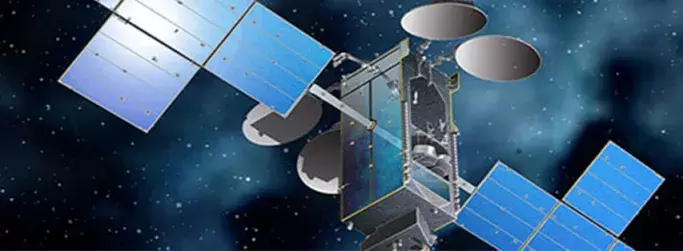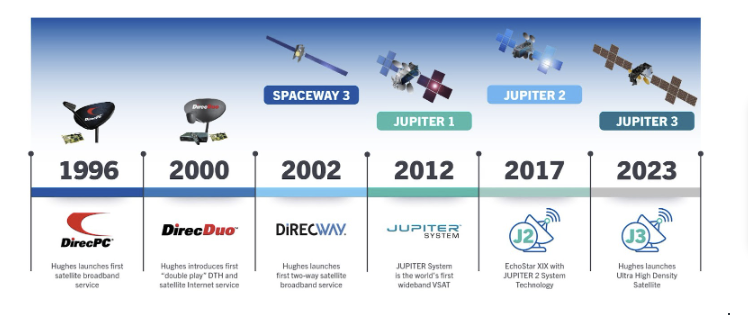
Satellite internet technology has evolved significantly since the 1990s. Several technological innovations have made high-speed satellite internet possible, which satellite internet companies capitalized on to define the future of the service. To understand how satellite internet service evolved into what it is today, it’s helpful to look back at the history of satellite technology.
History of Satellites
When was the first satellite launched?
In 1957, the Soviet Union launched the first satellite, Sputnik, into orbit and kicked the Space Race into high gear. The United States launched its answer to Sputnik, Explorer 1, the following year on January 31, 1958. While the Soviet satellite could only produce a high-pitched beep so ground control could track its movements, Explorer 1 could relay scientific data back to Earth and was the first satellite to detect the Van Allen radiation belt. After Explorer 1, the history of satellites moved quickly. NASA launched Tiros-1, the first weather satellite, in 1960, and Bell Labs’ first communications satellite was in orbit by the end of 1962. From there, satellite telecommunications rapidly evolved, developing the technology and capacity that led to satellite internet services.
The Early Days of Satellite Internet
Hughesnet Satellite Internet History

In 1996, Hughes Network Systems launched DirecPC, the world’s first satellite internet service for consumers and small businesses. DirecPC took its name from the satellite television service DirectTV, which was under shared ownership at the time. In 2000, Hughes introduced DirecDuo, the first direct-to-home satellite television and internet bundle.
DirecDuo changed its name to Direcway in 2002, when Hughes launched the first two-way satellite broadband service, giving satellite internet users the ability to upload as well as download data. Hughes parted ways from DirectTV in 2005 and changed the Direcway name to Hughesnet® in 2006.
In 2012, Hughes launched JUPITER™ 1. JUPITER 1 was the world’s highest-capacity broadband satellite at launch, with a capacity of 120 Gbps. In 2016, we launched the JUPITER 2, increasing our high-speed satellite internet service coast-to-coast across the continental United States. JUPITER 2 was the first satellite to meet the FCC’s definition of broadband, delivering speeds up to 25 Mbps.
Hughesnet’s latest and most powerful satellite, the JUPITER 3, launched in 2023 with two to three times the Ka-band capacity of the JUPITER 2. Capable of supporting in-flight Wi-Fi, maritime connections, enterprise networks, backhaul for Mobile Network Operators (MNOs), and Community Wi-Fi solutions, the JUPITER 3 increases the total capacity of the JUPITER fleet to 1 Tbps.
Technological Advancements in Satellite Internet
How many satellites circle the earth?
According to the United Nations Office for Outer Space Affairs, 11,330 satellites currently orbit the earth, including navigational, research, defense, and telecommunication satellites that make satellite internet possible. These satellites are categorized by their orbital altitudes:
- Geostationary Earth Orbit (GEO): Geostationary satellites match the earth's rotation and orbit at an altitude of 36,000 km (approximately 22,369 miles). As geostationary satellites move at the same speed as the Earth, they are in continuous and reliable contact with ground stations.
- Medium Earth Orbit (MEO): MEO satellites have orbits ranging from 5,000 to 20,000km (3,100 to 12,47 miles) and are often used for GPS and other navigation apps. MEO satellites also provide high-bandwidth data connectivity to government ag™™™encies and some commercial enterprises.
- Low Earth Orbit (LEO): Thousands of satellites lie in low Earth orbit at 500 to 1,200km (310 to 745 miles). Most LEO satellites are used for science, global imaging, and low-bandwidth telecommunication.
Benefits of Geostationary Satellites
Satellite technology improved significantly with the advent of geostationary satellites. A satellite in geostationary orbit remains in a fixed position above the Equator and mimics Earth’s rotation. The Hughesnet satellite fleet uses geostationary orbit to deliver reliable service, as the Earth never blocks the satellites’ signals. The first geostationary satellite was launched in 1963 by Hughes Aircraft Company (now Hughes Network Systems, LLC), whose success jumpstarted the development of satellite technology for television broadcasting, telecommunications, and military applications.
2023 saw the latest addition to the Hughesnet satellite fleet, the launch of the JUPITER 3 satellite. The world's largest and most advanced commercial communications satellite, the JUPITER 3 satellite provides more than 500 Gbps of capacity and allows Hughesnet internet plans to offer speeds of up to 100 Mbps.
High-throughput satellites like Jupiter 3 provide faster speeds and lower latency than previous satellites used for high-speed internet service. Almost all satellite internet companies now use high-throughput satellite technology to provide internet service to homes and businesses. How do we get massive satellites like the JUPITER 3 into orbit? Learn how satellites are launched!
Satellite technology has come a long way since its beginnings during the Space Race, and advancements continue to lead to more applications in our everyday lives. Hughesnet rural internet plans use the latest technology to offer high-speed satellite internet service, which continues to improve as new innovations are introduced. Our mission to provide the best possible internet to rural communities began with our first internet satellite in 1996.



